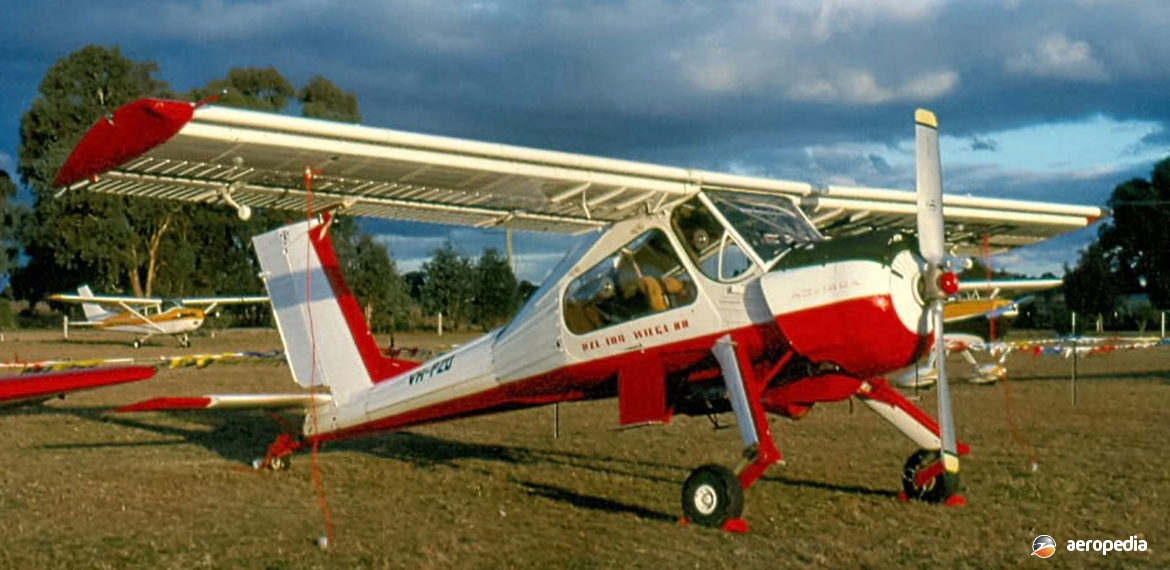Photograph:
PZL Wilga 80 VH-PZQ (c/n CF20900894) at Cowra, NSW in June 1993 (David C Eyre)
Country of origin:
Poland
Description:
Light utility transport
Power Plant:
One 194 kw (260 hp) Ivchenko AI-14RA nine-cylinder air-cooled radial ngine
Specifications:
- Wingspan: 11.12 m (36 ft 5¼ in)
- Length: 8.10 m (26 ft 6¼ in)
- Height: 2.96 m (9 ft 8½ in)
- Wing area: 15.5 m² (166.85 sq ft)
- Max speed: 194 km/h (120 mph)
- Cruising speed at 76% power: 157 km/h (97 mph)v
- Max range cruising speed: 137 km/h (85 mph)
- Stalling speed flaps down: 56 km/h (35 mph)
- Max rate of climb at sea level: 276 m/min (905 ft/min)
- Service ceiling: 4,040 m (13,250 ft)
- Range with max fuel, 30 mins reserves: 510 km (317 miles)
- Empty weight: 870 kg (1,918 lb)
- Loaded weight: 1,300 kg (2,866 lb)
History:
The Wilga (ie Thrush) was designed and built in Poland by Polskie Zaklady Lotnicze (PZL) as a light general purpose utility aircraft. The prototype, known as the Wilga 1 (SP-PAZ), fitted with an indigenous 145 kw (195 hp) Narkiewicz WN-6B engine, flew for the first time on 24 April 1962. However, this engine did not provide sufficient power and, because of weight problems, the aircraft was redesigned. A second prototype was built, known as the Wilga 2, this aircraft (SP-PAR) flying for the first time on 1 August 1963. Further engines were fitted to the Wilga over the years included, in 1962, the 134 kw (180 hp) Narkiewicz WN-6 six-cylinder unit, which in the WN-6R variant had power increased to 164 kw (220 hp), and a 165 kw (220 hp) Continental but most of the more than 900 completed were powered by the 194 kw (260 hp) Ivchenko AI-14RA radial.
The Wilga was produced to meet a variety of requirements, including glider towing, parachute dropping, light transport, agricultural work, and aerial ambulance work. In the latter role provision was made for a doctor and two stretcher patients. Production commenced in 1966 and a number of components were exported to Indonesia where it was assembled as the Lipnut Gelatik, later being licence-built, these aircraft being fitted with a 172 kw (230 hp) Lycoming O-470 engine and being used in the agricultural role.
Of all-metal construction, some of the outer covering is corrugated for greater strength and rigidity. A fixed slot extends over the whole of the leading edge of the wing, and slotted flaps and frise type ailerons take up the whole of the trailing edge. The aircraft is extremely rugged and models available have included the Wilga 3A for club use; Wilga 3S air ambulance; Wilga 32 with a 172 kw (230 hp) Continental engine; Wilga 35 with the Ivchenko engine; Wilga 35A also for aero club use; Wilga 35H and 80H with Airtech (Canada) LAP-3000 floats; Wilga 35P liaison aircraft; and 35R agricultural aircraft. The first Wilga 35 flew on 28 July 1967.
Accommodation was provided for a pilot and three passengers. Baggage capacity behind the seats was 35 kg (77 lb). In the glider towing role a single glider up to 650 kg (1,433 lb) or two or three gliders with a total combined weight of 1,125 kg (2,480 lb) could be operated. Fuel capacity was 195 litres (43 Imp gals) and more than 1,000 Wilgas were built. In the USA the Wilga 80-550 was marketed with a 224 kw (300 hp) Continental IO-550 six-cylinder engine.
First of the type seen in this region was a Wilga 80 (SP-PWA) at the Australian Bicentennial Airshow at Richmond, NSW, in October 1988. Since then a number have been imported, a couple being used on tourist flights. Examples registered have included VH-PZZ (c/n CF15820613), VH-PZQ (c/n CF20900894), VH-PSZ (c/n CF14800557), VH-AQX (c/n CF21920938) and VH-PZS (c/n CF15810600), which was lost in an accident at Dunwich, QLD on 12 January 1996.
One Wilga VH-PSZ was fitted with floats and operated on tourist flights by Paradise Seaplanes from Point Vernon in Queensland. Another was registered as VH-ONN (c/n 74205 – ex D-ETVS, [9H-ADW], D-ETVS, SP-FWV, 206 Polish Air Force) on 7 May 2010 and was owned by Toy Box WA Pty Ltd. Further examples have included VH-ZLD (c/n 0097002) and VH-VMG (c/n 59047404).
First of the type in New Zealand was ZK-PZL (c/n 20900898), assembled at Ardmore in November 1991, followed by ZK-PZM (c/n 140542), ZK-PZN (c/n 140548), ZK-PZO (c/n 19870860), ZK-PZP c/n 20890880), ZK-PZQ (c/n CF21930941) and ZK-NEV (c/n 140526). All of these, with the exception of ZK-NEV, were imported by Alternate Aviation. Later ZK-PZP was exported to Spain, going on to the United Kingdom in 1995; ZK-PZQ was exported to the United Kingdom that same year; ZK-PZO was damaged in a landing accident at Wanaka in November 1999; and ZK-PZL was cancelled on 27 March 2013 as destroyed. A further Wilga was imported as ZK-PZL (c/n 19840819 – ex LZ-VET) and was registered on 2 April 2013.
Construction was all aluminium. The aircraft was a high-wing utility transport with some STOL capability. The cabin was all-metal riveted and corrugated to provide strength. The single-spar wing was fitted with slotted flaps and anti-stall slats. Seating was provided for two and entry was via two doors, one on each side, these opening upwards to facility loading and unloading. The undercarriage was tailwheel, was articulated and had fixed pneumatic shock absorption. It had a sprung tailwheel and a glider tow hook. Examples of the Wilga 2000 have also been imported and have been dealt with separately.

